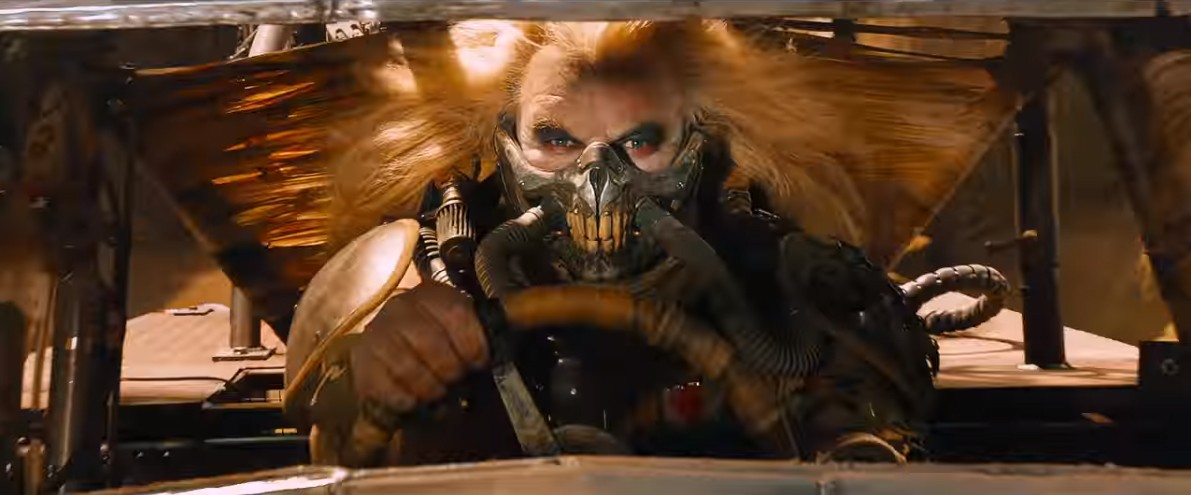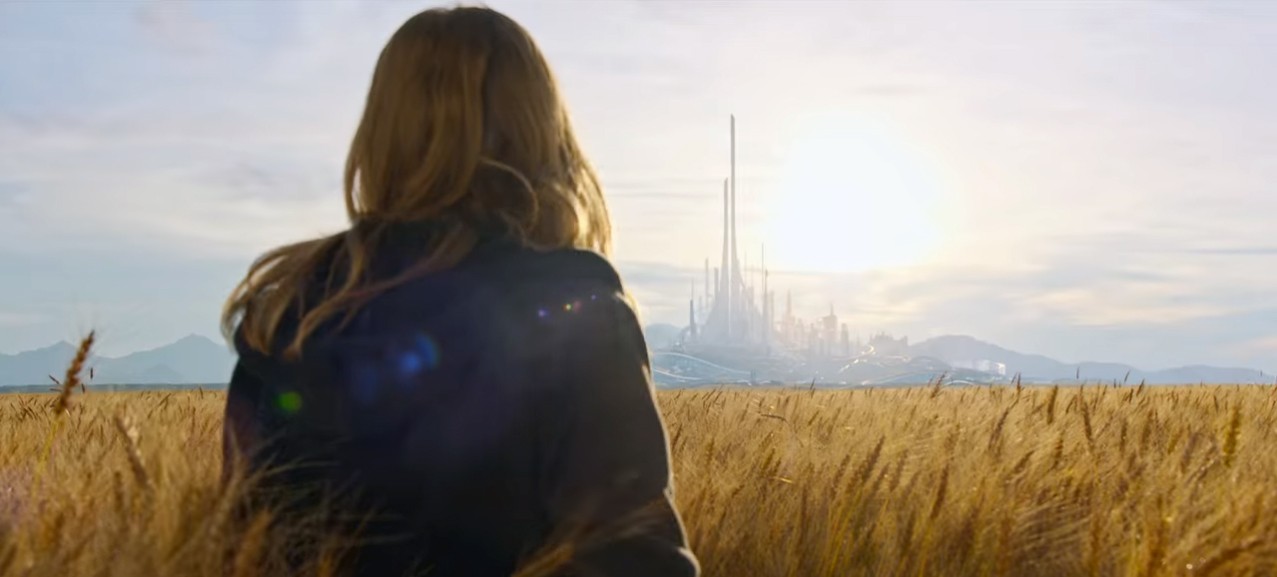This past Memorial weekend was a cinematic roller-coaster for me: first, I stumbled out of Mad Max: Fury Road stunned and bleary-eyed, then I floated rather happily out of Disney’s Tomorrowland with a mildly saccharine taste in my mouth (as opposed to blood), with visions of jet packs dancing in my head. Yet despite the wildly different approaches to storytelling the two movies take to the apocalypse, I was surprised to find that their message really isn’t all that different. (Spoilers abound.)
Like many other film-goers who begrudgingly agreed to see Mad Max at their friends’ insistence, I had no idea what I was getting into when I sat down to pick up where Mel Gibson left off thirty years ago. Little did I know this Mad Max “re-imagining” was a decade in the making, pregnant with visuals so kaleidoscopically violent that I suspect the whole action-movie formula will need to be “re-imagined” as well, after its release. On the other hand, I didn’t have any illusions about what I was getting into when I sat down for Tomorrowland: after all, it’s not like the film is hiding the fact that it was conceived in a theme park. In fact, Tomorrowland‘s retro-futurist moralizing is a refreshing two-by-four to the forehead in a cinema climate where doom and gloom hug the emaciated hips of every blockbuster like a little black dress.
Blast from the past: It’s 2009, the new Star Trek just came out. For those of us who grew up with the Next Generation franchise, we look to Trek as being one of the few scifis out there that believes in a future where everything’s actually kind of great, and most humans aren’t selfish assholes trying to blow each other up. But new Star Trek concluded with a particularly vexing scene: the villain’s spaceship, the Narada, is being sucked into a black hole after it has been crippled by the Enterprise in a firefight. When new Kirk asks if his arrogant Romulan nemesis wants to surrender, the Romulan naturally refuses, but instead of doing what you’d imagine a humanitarian like Kirk would do (that is, save his enemy’s prideful ass anyway) Kirk unloads on the ship, unprovoked, and blows it into oblivion. This slow descent of missing the message for the missile over the past half a decade has only gotten deeper since, making movies like Tomorrowland almost subversive in their attempts to moralize.

While the narrative is framed awkwardly and gets off to a slow start, the gist of Tomorrowland is that crotchety Frank Walker (George Clooney) and bright-eyed Casey Newton (Britt Robertson) are exiled geniuses—both perhaps named after modern-day inventors—who serve as the next generation of “dreamers” that are destined to assume the mantle of restoring Tomorrowland to its former glory: that of an utopian pocket dimension for the intellectual one-percent. Like Olympians taking over the world after the fall of the Titans, Casey and Frank are joined by a clever automaton named “Athena” (Raffey Cassidy), who, let’s not forget, is legended to have sprung fully-armed from the king of the gods’ forehead into existence, all the while newly appointed Governor David Nix (Hugh Laurie) overshadows the future with darkness, a little like the Titaness Nyx.
Is Tomorrowland Brad Bird’s version of Galt’s Gulch? The media’s conflation of this film with Objectivism is fun for shooting the shit, but it just doesn’t stick: while it’s true that Tomorrowland was created by entrepreneurial types (Tesla, Edison, Eiffel via “Plus Ultra”), the goal of the utopia is to make the world a better place for everyone outside it. If anything, Tomorrowland is the ultimate government program, a kind of technocratic super-NASA that never existed and wasn’t the bi-product of a Cold War arms race. The only real enemy in Tomorrowland is ourselves: our own taste for monstrosity, which in the film is literally fed to us by a tachyonic feedback loop of negativity called The Monitor.
And that’s where Mad Max: Fury Road curiously begins to dovetail with its bushy-tailed sibling in the box office. Frank and Casey’s “eternal return” is to The Monitor, a dark tower in a fallen paradise that holds the key to discovering real progress in the world, which sounds a lot like the circular journey to the Citadel of Max (Tom Hardy) and Imperator Furiosa (Charlize Theron). And while the style of storytelling in Mad Max is quite the opposite of Tomorrowland‘s “shiny chrome”—an in-your-face, frenetic psychosis of explosions and bass—both movies depict one giant chase scene that consists of running from pursuers who want to keep the status quo and a world lorded over by a delusional maniac who believes in giving the plebes exactly the mythology they need in order to keep them complacent.
Of course, I’m not arguing that both movies handle their subject matter equally adroitly. There’s a lot to be said about the presence of strong female leads in both movies, and what this means for the genre and so on, but I have to say that despite how much I love Athena as a character in Tomorrowland, she’s still literally a puppet of the men who run the pocket universe, much like Casey herself, who’s caught between the warring ideologies of Frank and Nix. And speaking of Nix, it’s a damn shame that his fantastic monologue is responded to by the main characters with violence:
To save civilization I would show its collapse. How do you think this vision was received? How do you think people responded to the prospect of imminent doom? They gobbled it up, like a chocolate éclair! They didn’t fear their demise, they repackaged it! It can be enjoyed as video games, as TV shows, books, movies—the entire world wholeheartedly embraced the apocalypse and sprinted toward it with gleeful abandon! Meanwhile, your earth was crumbling around you. You’ve got simultaneous epidemics of obesity and starvation! … In every moment, there is the possibility of a better future. But you people won’t do what is necessary to make it a reality, so you dwell on this little terrible future and you resign yourself to it, for one reason: Because that future doesn’t ask anything of you, today.
Nix might be as misguided as Ozymandias in Watchmen, but instead of redeeming him, Tomorrowland blows him up rather new-Star Trek-like.
In Mad Max, despite the spectacularly high incidence of vehicular homocide and exsanguination of the population, it’s still possible for everyone in the main cast to be redeemed. (I’m lookin’ at you, Nux!) But the road to redemption isn’t paved with dreamers. In the desert, Max argues that “Hope… is a mistake. If you can’t fix what’s broken, you’ll go insane.” In the context of the scene in which it is delivered, Max’s message reads like advice to just let go or give up. But the next day, he tries to get Furiosa to abandon her idealistic search for the Green Place and effect real change by taking control of the Citadel. It turns out his simple advice has the same import as Casey’s naive ask at the beginning of Tomorrowland: “I get things are bad, but what are we doing to fix it?” In both movies, hope isn’t a fuel that the future can run on indefinitely: while the Green Place initially serves as an idea Furiosa aspires toward, she eventually has to face the grim reality that the Green Place maybe never existed, and has to be built, like Frank’s future that never was. “It isn’t hard to knock down a big evil building that’s telling everybody’s that the world’s going to end,” says Frank after doing exactly that, “what is hard is figuring out what to build in its place.” With Frank and Casey working toward building a new Tomorrowland and Furiosa and the Vuvalini working toward governance of the Citadel, the question of “the doing” that comes after “the dreaming” becomes the final resting place for both movies, which is in itself the real aspirational question of our century.

One of my favorite moments in Fury Road doesn’t involve an explosion—it’s a heartfelt scene like the one Disney ham-fists in the opening frame of Tomorrowland—a quiet space in the narrative between the mirrored journeys in and out of the Citadel, shortly after Furiosa meets the Vuvalini. Looking up at the night sky, one of the Wives points out a falling star:
VUVALINI: “That’s what you call a satellite.”
TOAST THE KNOWING: “Miss Giddy told us about those, they used bounce messages across the earth.”
VUVALINI: “Shows, everyone in the old world had a show.”
TOAST THE KNOWING: “Do you think there’s still somebody out there, sending shows?”
What a beautiful, optimistic message, don’t you think? In the midst of all the carnage, and even after the world is “killed,” there still might be “somebody out there, sending shows.” Not unlike Frank, listening in on a distant signal from a broken Tomorrowland, or Max disappearing into a Aqua Cola-renewed throng of the redeemed: there will always be “a little life with dried tubers,” it seems, no matter how dry or distant the wasteland.



